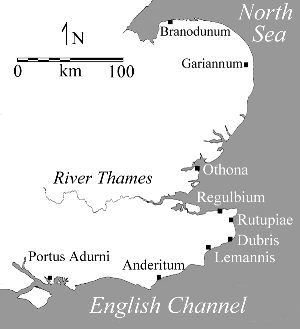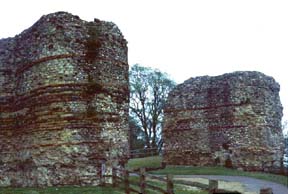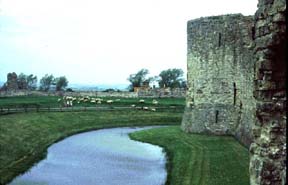| Athena Review Vol.1, no.2
| | |
The Saxon Shore Forts: Coastal defenses of Roman Britain | | | | |
|
The
Saxon Shore Forts were built by the Romans in the late 3rd century AD
along the southeast coast of Britain to guard against increasing
invasion and piracy by Germanic tribes including the Angles, Saxons,
and Jutes. Our only written source for this system of forts is a late
4th century document called the Notitia Dignitatum (Latin for "worthy of record"). The Notitia
records that the military commander known as the Count of the Saxon
Shore controlled nine forts, the names of which are given as well as
the units garrisoned in each.
 Third century unrest along the Rhine frontier:
The 3rd century witnessed a slow but growing encroachment on Roman
territories by Germanic tribes. Breaches in frontier security became
more frequent, until in 250-260 Rome's claim to the land east of the
Rhine was at first compromised, then eventually lost. Germanic tribes
including the Alemanni took full advantage of confusion caused by the
258 AD usurpation of Gaul by Postumus. Defensive operations by the
legitimate emperor Gallienus (AD 253-268) seriously diverted Roman
troops and gave Germanic tribes a golden opportunity to push past the
Rhine into Roman territory. Third century unrest along the Rhine frontier:
The 3rd century witnessed a slow but growing encroachment on Roman
territories by Germanic tribes. Breaches in frontier security became
more frequent, until in 250-260 Rome's claim to the land east of the
Rhine was at first compromised, then eventually lost. Germanic tribes
including the Alemanni took full advantage of confusion caused by the
258 AD usurpation of Gaul by Postumus. Defensive operations by the
legitimate emperor Gallienus (AD 253-268) seriously diverted Roman
troops and gave Germanic tribes a golden opportunity to push past the
Rhine into Roman territory.
Fig.1: Map of Saxon Shore forts in Britain (Athena Review).
The sea frontier in Britain:During
this period of unrest, the Franks and Saxons increasingly harrassed sea
traffic in the English Channel, impeding the transfer of  goods and
precious metals from Britain to Rome. Coin hoards dating from AD
270-285 found in southeast Britain suggest growing concerns with local
security. To protect against invasion, a series of forts were
installed along the coast as bases for the Classis Britannica, the Roman fleet in Britain. These naval bases were called Castrorum ("forts") of the Litus Saxonicum ("Saxon Shore"). goods and
precious metals from Britain to Rome. Coin hoards dating from AD
270-285 found in southeast Britain suggest growing concerns with local
security. To protect against invasion, a series of forts were
installed along the coast as bases for the Classis Britannica, the Roman fleet in Britain. These naval bases were called Castrorum ("forts") of the Litus Saxonicum ("Saxon Shore").
Fig.2: Roman gate at the Saxon Shore fort at Anderitum or Pevensey (photo: Athena Review).
The
array of Saxon Shore forts stretched from Portchester (Portus Adurni)
to Branodunum on the north Norfolk coast. The forts were equipped with
towers and gates, from which artillery units armed with onagers and
ballistae could hold a  charging enemy at bay. The onager ("wild ass") is a large catapult capable of hurling stones some 400 yards (fig.3). The ballista,
operated from towers by a pair of soldiers, is essentially a crossbow
mounted on a waist-high stand. The Saxon Shore Forts provided a
successful check against Germanic military invasion and piracy until
the Roman withdrawal in the early fifth century AD. charging enemy at bay. The onager ("wild ass") is a large catapult capable of hurling stones some 400 yards (fig.3). The ballista,
operated from towers by a pair of soldiers, is essentially a crossbow
mounted on a waist-high stand. The Saxon Shore Forts provided a
successful check against Germanic military invasion and piracy until
the Roman withdrawal in the early fifth century AD.
Fig.3: Roman onager or catapult.
The Notitia Dignitatum: Our source for the fort names, the Notitia Dignitatum,
is a late Roman collection of administrative information, roughly
accurate for 395-430 AD. The military sections of the document give a
great number of place names, providing a framework for archeological
evidence. All surviving copies derive from an 11th century copy of the
original known as the Codex Spirensis (now lost).

The
visitor today to the southeast coast of Britain may see ruins of the
Saxon Shore forts at Richborough (Rutupiae), Lympne (Lemanis),
Portchester (Portus Adurni) and Pevensey (Anderitum). The latter was
also the site of the first landing of William the Conquerer in AD 1066,
and was rebuilt into a Norman fort, of which substantial portions of
the wall and keep remain (fig.4).
Fig.4: Norman moat and turret at Pevensey (photo: Athena Review).
.
|
|
| Main
index of Athena Review
Copyright © 2023 Rust Family Foundation
(All Rights Reserved). | | |
.
|